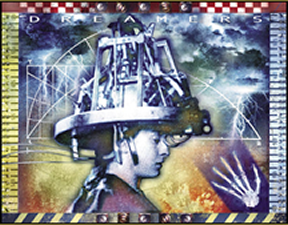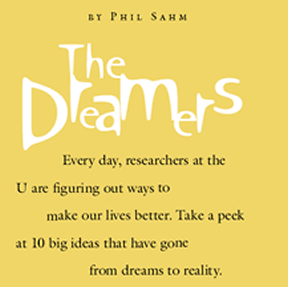
| Vol. 14 No. 2 | Fall 2004 |
 |
 |
A few million years ago on the plains of Africa, an enterprising early hominid came up with the smart idea of attaching a sharpened stone to a long stick to hunt animals and fend off predators.
But the naysayers scoffed.
So, this thinker and a couple of helpers (who later came to be called lab assistants) undertook fieldwork to test the hypothesis. The tribe gave them a week’s provisions to refine this new invention, prove that it worked, and bring back empirical data—along with some meat.
Thus, by Paleolithic standards, the first research grant was proposed and funded—and humankind was better for it.
From the earliest need to develop tools to modern string theory, which explains the expanding universe in 11 dimensions, ideas have propelled humanity forward—and they are in rich supply at the University of Utah. In the lab and across the globe, U of U researchers are, to borrow a line from Bob Dylan, using “ideas as their maps” to push the bounds of knowledge and make the world better.
In the spirit of those who dedicate themselves to research, Continuum presents 10 great ideas from University researchers, ranging from gene targeting to artificial vision to the theory that grandmothers play a much bigger role in society than we thought. Their ideas are creative, thought provoking, and important.
And they remind us that we don’t have to look too far to see that groundbreaking research is alive and flourishing at the University of Utah.
| How Old Are We? Frank Brown: Dean, College of Mines and Earth Sciences; Distinguished Professor of Geology and Geophysics In the human species’ great identity crisis—the need to understand from whom and where we came—Brown’s work may help redefine our ancestry. In 1980, paleontologist Richard Leakey, of the legendary Leakey family, asked Brown to work with him in the Lake Turkana basin in Kenya, Africa. By chemically analyzing layers of volcanic ash, Brown determined the order of the layers put down by ancient volcanic eruptions. An Australian scientist, Ian McDougall, then dated the age of each layer. From this, Leakey and his wife, Meave, were able to date some of the oldest human fossils. In 2001, Meave Leakey announced the finding of a skull west of Lake Turkana that Brown and McDougall dated to 3.5 million years. The skull and partial jaw are of a genus and species completely separate from that of Lucy, the small female skeleton unearthed in Ethiopia in 1974 that, until now, was considered to be the oldest living modern human ancestor. It is highly unlikely that each is our relative—which has raised an interesting familial debate.
Rapid PCR Technologies Carl Wittwer: Professor of Pathology Polymerase chain reaction (PCR) is a way to multiply the copies of a specific region of DNA molecules to produce a viable quantity to use for testing in a laboratory. In 1988, after joining the Department of Pathology faculty, Wittwer read an article about PCR and realized the technique could save a lot of work in the laboratory. But at the time there were no commercially available PCR machines. He figured out how to use hot air and capillary tubes to perform PCR. Then, with his expertise in enzyme kinetics (the rate at which enzymes work) and using fluorescence detection methodology, he built the first LightCycler™. The machine changed PCR from something that took hours to a rapid-fire process that can be monitored in real time to test for pathogens and diseases in minutes. Laboratories worldwide use the LightCycler™, which is made by Idaho Technology, Inc., the company he co-founded. Wittwer’s invention has become an important clinical assay system worldwide and is used in diagnostic tests to detect and characterize mutations in disease-related genes.
Computer Imaging Christopher Johnson MS’84 PhD’90: Director, School of Computing and the Scientific Computing and Imaging Institute; Distinguished Professor of Computer Science From computer visualization so sophisticated that surgeons can plan complex operations before they take a scalpel in hand, to the imaging of bioelectrical fields that evaluate the efficacy of external cardiac defibrillators, Johnson’s wizardry with computers is showing the full potential of medicine and technology working together. His vision laid the foundation for the Scientific Computing and Imaging Institute. SCI was established as a research group in 1994 and became an institute in 2000. Among its four goals: to research new techniques for scientific visualization and to develop visual analysis tools that help increase the understanding of complex scientific data. Operations as delicate and complex as removing tumors have been planned in advance based on SCI’s imaging capabilities. Along with medicine and biomedical science, the institute also works in providing visualization for energy exploration and fire simulation for the government. As if he isn’t busy enough, Johnson also holds appointments in bioengineering and physics.
Gene Targeting Mario Capecchi: Co-Chair, Department of Human Genetics; Distinguished Professor of Genetics and Biology “Revolutionize” is a word often used carelessly, but when describing the impact of gene targeting—or knockout mice technology—on medical and scientific research, it is precisely the right word. By learning how to snip out the middle of a mouse gene and replace it in the mouse chromosome with a modified version, Capecchi helped shape the way modern medical research is conducted. He is one of three researchers in the world credited with developing gene targeting, which allows medical researchers to reproduce mice with mutations in virtually any gene in order to study diseases or maladies ranging from cancer, cystic fibrosis, and heart disease, to diabetes, high blood pressure, and atherosclerosis. Today, gene targeting is standard practice for medical and scientific research worldwide.
The Grandmother Theory Kristen Hawkes: Distinguished Professor of Anthropology Everyone knows grandmothers pass along the most valuable family possessions: Recipes. Turkey stuffing. Chocolate chip cookies. But if Hawkes is right, they may be passing along a lot more than originally thought. Unlike other primates, human females often live three or four decades past their reproductive years. That anomalous fact flies in the face of the theory of evolution because natural selection tends to weed out those traits that don’t favor reproduction. But after studying the Hadza, a group of hunter-gatherers in northern Tanzania, Hawkes realized a curious thing: Hadza grandmothers, evidently extremely healthy and fit into their 60s, were gathering food for their weaned grandchildren to eat while their own daughters were breast feeding their youngest children. As Hadza grandmothers feed older children, the young mothers can breast feed for shorter periods and bear more offspring. This may help ensure that the genes of the long-lived grandmothers get passed down to succeeding generations. Hawkes, a former chair of the Department of Anthropology and member of the National Academy of Sciences, published her findings in the journal Nature this year to widespread acclaim—and controversy.
Magnetic Plastics Joel Miller: Distinguished Professor of Chemistry From telephones to televisions to cars, magnets are indispensable to the machinery of modern life. But the kind Miller has become internationally recognized for aren’t the ferrous-metal variety most people know. The polymer magnets he produces at room temperature are easier to make, retain their properties at higher temperatures, and remain stable in air, which suggests they may be suitable for a variety of applications, including as memory-storage devices and magnetic shielding. These new polymer magnets are made of vanadium and other materials. Miller and his Utah colleagues also are collaborating with a group of Ohio State researchers on a new kind of plastic that shows promise for use in magnetic computer memory—spintronics—and would allow electrons to store and transfer twice as much data. Data could also be stored permanently and would be almost instantly accessible, meaning no more lengthy boot-up time.
Mass Spectrometer Analysis James Ehleringer: Distinguished Professor of Biology By weighing the atoms of chemicals with a mass spectrometer, and then comparing the ratios of various isotopes, Ehleringer can determine the origin of just about any substance in the world with 95 percent accuracy. That’s not good news for drug cartels, counterfeiters, or terrorists. He can determine whether heroin was grown in South America or Southwest Asia, or if cocaine was cultivated in Peru or Ecuador. In cocaine, for example, the ratio of nitrogen-15 (a rare isotope) to nitrogen 14 (a common one), reveals the type of soil the coca plant was grown in and, ultimately, where that soil is located. In the mid-1990s, Ehleringer helped link counterfeit money to terrorists on the move by identifying the isotopes of rainwater that grew the cotton used to make the funny money. The isotopes proved to be unique to the climate of Eastern Europe. Ehleringer’s method is so accurate that the Drug Enforcement Administration has asked for his help in tracking international drug dealers.
HIV/AIDS Research Wesley Sundquist: Professor of Biochemistry Sundquist has dedicated his research to unlocking the structural basis of how HIV, the virus that causes AIDS, assembles and escapes from cells, a process known as “budding.” Along with other U researchers, he has identified and characterized a key protein that helps HIV escape from cells. Without this protein, Tsg101, HIV cannot leave cells and spread in the body. In his other major area of research, Sundquist studies the proteins Matrix and Capsid, which are key organizers of HIV. By looking at their three-dimensional structures, he hopes to understand how these proteins help assemble the virus core. Because drugs bind to proteins, identifying and understanding proteins is critical for developing drugs to attack HIV. With three out of four HIV patients in the United States resistant to at least one drug, and 15 percent of new HIV infections drug-resistant, finding new drugs is paramount in fighting HIV, according to Sundquist.
Thermoacoustic Devices for Refrigeration Orest Symko: Professor of Physics Even computers get overworked, which means circuits become overheated. Symko is developing environmentally clean devices that create refrigeration to cool overheated electronics by taking advantage of the relationship between sound and heat. Sound is created by rapid oscillations in air pressure. Temperature goes up as air compresses and pressure rises. When pressure drops, air expands and cools. Symko is making mini-refrigerators from sound. The refrigerators, as small as a half-inch long and with few moving parts, use air or other simple gases that don’t pollute. Ultrasonic pulses of air are pushed in one direction through a barrier inside the mini-refrigerator, intensifying as it moves through the body of the device. This causes one side of the barrier to be warm and the other side to be cool, creating an effect much like a refrigerator. Because the noise is ultrasonic, people can’t hear it. Devices small enough to cool circuits in laptop computers, or just about any electronic device, can be manufactured.
The Utah Artificial Vision System Richard Normann: Professor of Ophthalmology and Visual Sciences What once could only be imagined may soon be reality: blind people will have sight. But vision won’t come through the optic nerve and the eye. It will be relayed through the visual cortex of the brain, and Normann’s singular focus will play a large role in this accomplishment. The Utah Artificial Vision System includes a pair of glasses equipped with a hidden micro-video camera that changes light into electrical signals; a processing system that converts the electrical signals into patterns of stimulation for the brain; and a power source that is neatly carried in a shirt pocket. The system also includes an implanted multichannel stimulator, with data and power delivered through a telemetry link. Central to the system is the Utah Electrode Array (UEA), which comprises 625 microelectrodes implanted in the brain’s cortex to stimulate neurons to create scoreboard-like “vision.” The goal is for the individual to be able to navigate without the help of a guide dog or human being and to be able to read printed text. —Phil Sahm BS’78 is a writer in the Office of Public Affairs for the Health Sciences Center. |